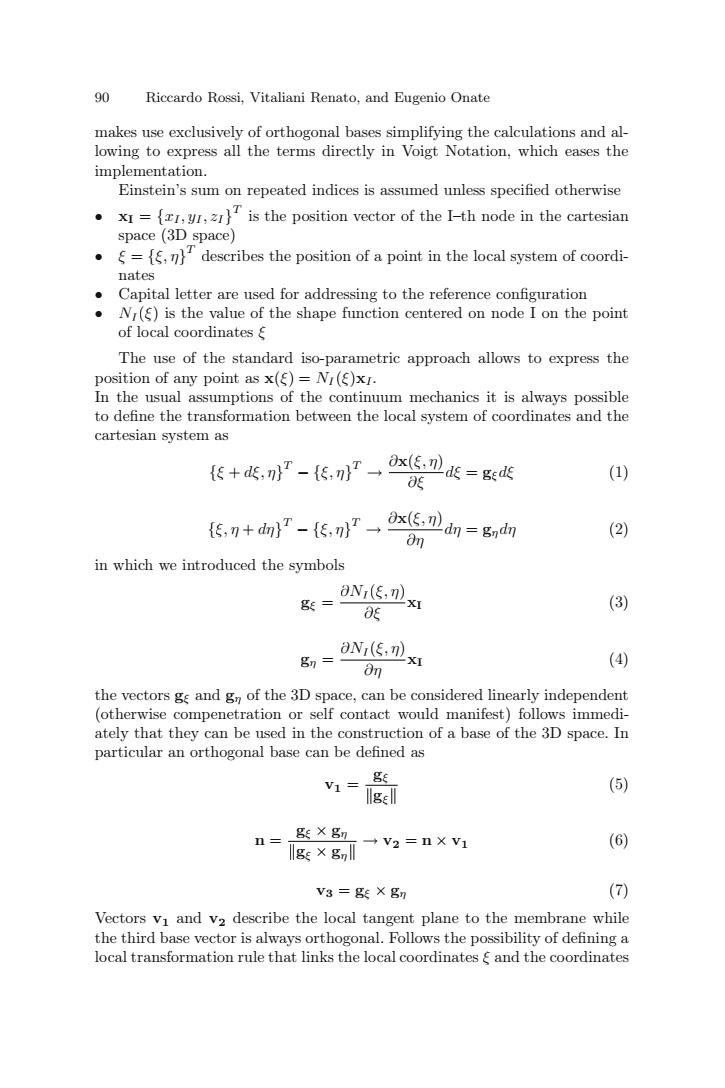正在加载图片...

90 Riccardo Rossi,Vitaliani Renato,and Eugenio Onate makes use exclusively of orthogonal bases simplifying the calculations and al- lowing to express all the terms directly in Voigt Notation,which eases the implementation. Einstein's sum on repeated indices is assumed unless specified otherwise .xI=,is the position vector of the I-th node in the cartesian space(3D space) .={describes the position of a point in the local system of coordi- nates Capital letter are used for addressing to the reference configuration Nr(g)is the value of the shape function centered on node I on the point of local coordinatesξ The use of the standard iso-parametric approach allows to express the position of any point as x()=NI()xI. In the usual assumptions of the continuum mechanics it is always possible to define the transformation between the local system of coordinates and the cartesian system as 长+,P-长,P-0x5=gG ∂灰 (1) {长,7+dr-长,nr-05l=g, (2) in which we introduced the symbols gE= aN,x灯 (3) DE gn= aN,dx灯 8n (4) the vectors ge and gn of the 3D space,can be considered linearly independent (otherwise compenetration or self contact would manifest)follows immedi- ately that they can be used in the construction of a base of the 3D space.In particular an orthogonal base can be defined as v1二ge gE (5) n= g:X gn →V2=nXV1 (6) lge×gml V3=g X gn (7) Vectors vI and v2 describe the local tangent plane to the membrane while the third base vector is always orthogonal.Follows the possibility of defining a local transformation rule that links the local coordinates and the coordinates90 Riccardo Rossi, Vitaliani Renato, and Eugenio Onate makes use exclusively of orthogonal bases simplifying the calculations and allowing to express all the terms directly in Voigt Notation, which eases the implementation. Einstein’s sum on repeated indices is assumed unless specified otherwise • xI = {xI , yI , zI } T is the position vector of the I–th node in the cartesian space (3D space) • ξ = {ξ, η} T describes the position of a point in the local system of coordinates • Capital letter are used for addressing to the reference configuration • NI (ξ) is the value of the shape function centered on node I on the point of local coordinates ξ The use of the standard iso-parametric approach allows to express the position of any point as x(ξ) = NI (ξ)xI. In the usual assumptions of the continuum mechanics it is always possible to define the transformation between the local system of coordinates and the cartesian system as {ξ + dξ, η} T − {ξ, η} T → ∂x(ξ,η) ∂ξ dξ = gξdξ (1) {ξ, η + dη}T − {ξ, η} T → ∂x(ξ, η) ∂η dη = gηdη (2) in which we introduced the symbols gξ = ∂NI (ξ, η) ∂ξ xI (3) gη = ∂NI (ξ, η) ∂η xI (4) the vectors gξ and gη of the 3D space, can be considered linearly independent (otherwise compenetration or self contact would manifest) follows immediately that they can be used in the construction of a base of the 3D space. In particular an orthogonal base can be defined as v1 = gξ gξ (5) n = gξ × gη gξ × gη → v2 = n × v1 (6) v3 = gξ × gη (7) Vectors v1 and v2 describe the local tangent plane to the membrane while the third base vector is always orthogonal. Follows the possibility of defining a local transformation rule that links the local coordinates ξ and the coordinates����